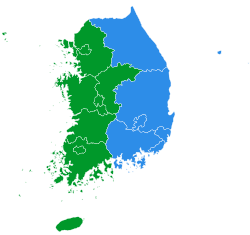South Korean presidential election, 1997
|
| |||||||||||||||||||||
| |||||||||||||||||||||
| |||||||||||||||||||||
 Results by province and city ■ – Kim Dae-jung | |||||||||||||||||||||
| |||||||||||||||||||||
Presidential elections were held in South Korea on 19 December 1997. The result was a victory for opposition candidate Kim Dae-jung, ending almost 36 years of conservative rule.[1] When he took office in 1998, it also marked the first time in Korean history that an incumbent government peacefully surrendered power to the opposition.
Nominations
National Congress for New Politics
The NCNP National Convention was held on 19 May at Olympic Gymnastics Arena. Kim Dae-jung, a former 6-term lawmaker from South Jeolla, was nominated for president, defeating Chyung Dai-chul, a former 4-term lawmaker from Seoul.[2]
| Candidate | Delegates | % |
|---|---|---|
| Kim Dae-jung | 3,223 | 78.04 |
| Chyung Dai-chul | 907 | 21.96 |
| Invalid/blank votes | 27 | – |
| Total | 4,157 | 100 |
New Korea Party
The ruling New Korea Party's presidential nominating convention took place on 21 July at Olympic Gymnastics Arena, during which former Prime Minister Lee Hoi-chang defeated former Gyeonggi governor Lee In-je after two rounds of voting and became the party's nominee.[3]
| Candidate | First round | Second round | ||
|---|---|---|---|---|
| Delegates | % | Delegates | % | |
| Lee Hoi-chang | 4,963 | 41.13 | 6,922 | 59.96 |
| Lee In-je | 1,776 | 14.72 | 4,622 | 40.04 |
| Lee Han-dong | 1,771 | 14.68 | ||
| Kim Deok-ryong | 1,674 | 13.87 | ||
| Lee Soo-sung | 1,648 | 13.66 | ||
| Choi Byung-ryul | 236 | 1.96 | ||
| Total | 12,068 | 100 | 11,544 | 100 |
United Liberal Democrats
The ULD National Convention held on 24 June at Olympic Gymnastics Arena overwhelmingly nominated 8-term lawmaker Kim Jong-pil from South Chungcheong for president.[4]
| Candidate | Delegates | % |
|---|---|---|
| Kim Jong-pil | 2,575 | 82.29 |
| Han Young-soo | 554 | 17.71 |
| Total | 3,129 | 100 |
Democratic Party
On 11 September, the Democratic Party, once the premier opposition to the New Koreans but a fringe party ever since the defection of Kim Dae-jung's faction in 1995, nominated Seoul mayor Cho Soon for president.[5]
New National Party
On 4 November, former NKP politicians unhappy with Lee Hoi-chang founded the New National Party and nominated Lee In-je for president. This was after the scandal regarding Lee Hoi-chang's sons being excused from the military service hit the news cycle and brought Lee's popularity down.[6]
Coalitions
Anti-Ruling Party Coalition: the "D.J.P." Alliance
Kim Dae-jung, or "D.J." and Kim Jong-pil, or "J.P." agreed on 4 November to form an alliance against their common enemy, Lee Hoe-chang. In this agreement, JP announced to withdraw his bid for president to endorse DJ, and in turn DJ would appoint JP as the prime minister once elected president. The two Kims also agreed to revise the Constitution after the election from presidential system to parliamentary system, and the NCNP and ULD would cooperate on different issues as a coalition government.[7]
Anti-DJP Coalition: the Grand National Party
On the other hand, needing a breakthrough as Kim Dae-jung's popularity soared, Lee Hoe-chang and Cho Soon also agreed to combine forces. On 21 November, the New Korea Party and Democratic Party merged into one party, and was founded as the Grand National Party. Cho Soon was made the chairman of the party, and Lee Hoe-chang the candidate for president.
Results
| Candidate | Party | Votes | % of votes | |
|---|---|---|---|---|
| Kim Dae-jung | National Congress for New Politics (새정치국민회의) | 10,326,275 | 40.3% |  |
| Lee Hoi-chang | Grand National Party (한나라당) | 9,935,718 | 38.7% |  |
| Lee In-je | New National Party (국민신당) | 4,925,591 | 19.2% |  |
| Kwon Young-ghil | People's Victory for 21st century (건설국민승리21) | 306,026 | 1.2% | |
| Huh Kyung-young | Republican Party (공화당) | 32,918 | 0.2% | |
| Shin Jeong Yil | Unified Korea Party (한주의통일한국당) | 11,901 | 0.2% | |
| Kim Han-sik | Honest Politics Unite | 5,714 | 0.2% | |
| Invalid ballots | 400,195 | 0.6% | ||
| (Total electorate: 32,290,416 - Turnout rate: 80.7%) Total | 26,042,633 | 100% | ||
| regions · provinces · cities | .png) |
.jpg) |
NNP | |
|---|---|---|---|---|
| Kim Dae-jung NCNP |
Lee Hoi-chang GNP |
Lee In-je NNP | ||
| Sudogwon | Seoul | 44.9% | 40.9% | 12.8% |
| Incheon | 38.5% | 36.4% | 23.0% | |
| Gyeonggi | 39.3% | 35.5% | 23.6% | |
| Gangwon | 23.8% | 43.2% | 30.9% | |
| Chungcheong | Daejeon | 45.0% | 29.2% | 24.1% |
| Chungcheongbuk | 37.4% | 30.8% | 29.4% | |
| Chungcheongnam | 48.3% | 23.5% | 26.1% | |
| Honam (Jeolla) |
Gwangju | 97.3% | 1.3% | 0.7% |
| Jeollabuk | 92.3% | 4.5% | 2.1% | |
| Jeollanam | 94.6% | 3.2% | 1.4% | |
| Yeongnam (Gyeongsang) |
Busan | 15.3% | 53.3% | 29.8% |
| Ulsan | 15.4% | 51.4% | 26.7% | |
| Daegu | 12.5% | 72.7% | 13.1% | |
| Gyeongsangbuk | 13.7% | 61.9% | 21.8% | |
| Gyeongsangnam | 11.0% | 55.1% | 31.3% | |
| Jeju | 40.6% | 36.6% | 20.5% | |
See also
References
- ↑ "IFES Election Guide | Elections: Korea President 1997". www.electionguide.org. Retrieved 2017-04-25.
- ↑ http://news.joins.com/article/6212474
- ↑ 이인용,김지은. "신한국당 대통령 후보 이회창 당선[김상수]". imnews.imbc.com (in Korean). Retrieved 2018-04-24.
- ↑ http://imnews.imbc.com/20dbnews/history/1997/1979728_19482.html
- ↑ http://imnews.imbc.com/20dbnews/history/1997/1768728_19482.html
- ↑ http://news.donga.com/3/all/19971104/7296924/1
- ↑ http://imnews.imbc.com/20dbnews/history/1997/1770584_19482.html
| Wikimedia Commons has media related to President of South Korea. |
